Positioned one step and £200 above the entry-level Giant Contend 2, this Giant Contend 1 is still among the best road bikes under £1,000.
The Giant Contend range showcases the brand's extensive aluminium fabrication experience, with SL, SL Disc and all-road AR models complementing the regular Contend, which we have here, to offer something for most riders.
And while the Contend 1 might be one of Giant’s cheapest road bikes, it's not a machine to underestimate. It's an excellent all-round package for the money, with a rewarding ride and slick spec.
Giant Contend 1 specifications
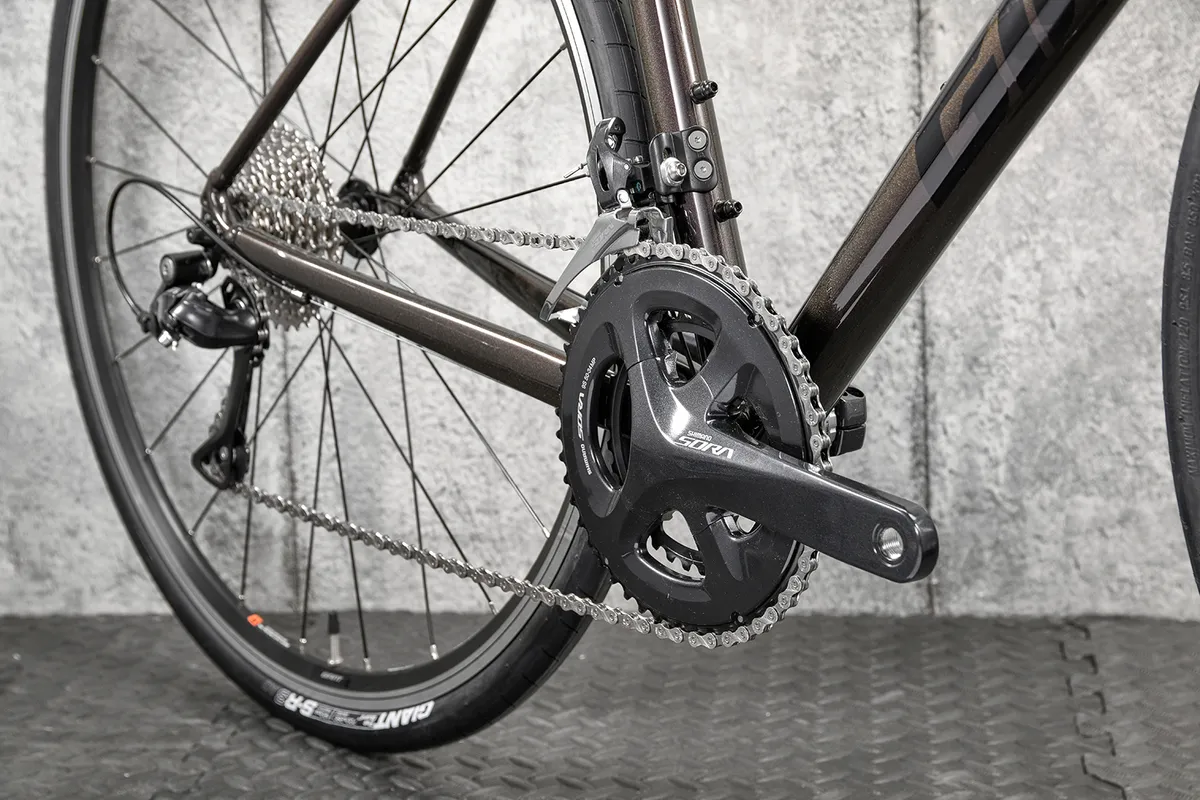
The frame is built using Giant’s proprietary Aluxx-Grade aluminium, with subtly shaped tube profiles. It has smooth, nicely finished welds that could resemble the flowing junctions of a carbon fibre frame from a distance.
Giant’s carbon fibre fork is termed Advanced-Grade Composite, with a full-composite OverDrive steerer, meaning it has a diameter of 1 ¼in, which is one eighth of an inch greater than standard.
The alloy seatpost follows Giant’s D-Fuse flat back design, with the aim of increasing seated comfort.
The groupset is Shimano’s smartly finished Sora nine-speed, with the only deviation being for Tektro rim-brake calipers. Giant provides the tubeless-ready wheelset and tyres, plus alloy bar and stem, and the saddle.
Giant Contend 1 geometry
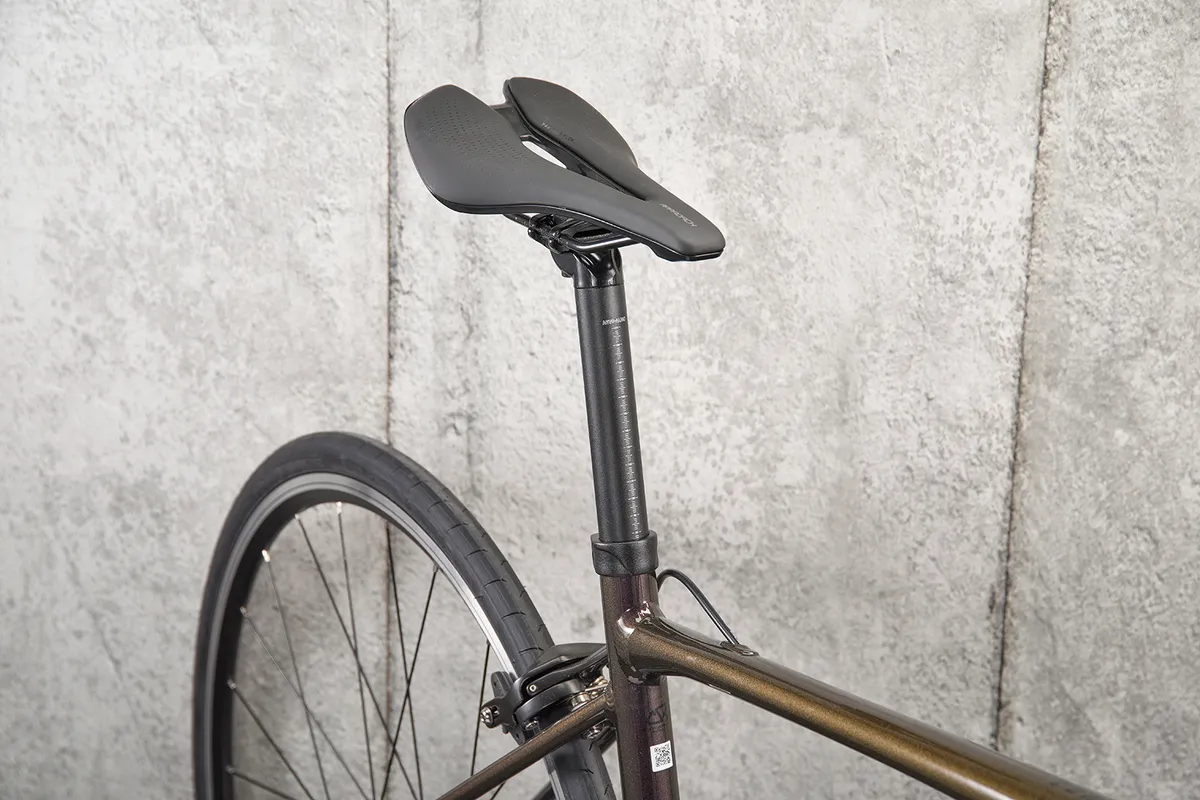
Compact Road Design has been the cornerstone of Giant’s road frame design since it was first launched in the mid-nineties. Its sloping top tube creates smaller triangles, which are lighter and stiffer, and also makes it easier for the frame to fit a wider range of riders.
The medium-size Contend tested here sticks to this tried and trusted principle, with a 158mm head tube, 545mm effective (horizontal) top tube, 73.5-degree seat angle and 72.5-degree head angle, with short 412mm chainstays helping to create a fairly compact 990mm wheelbase.
The bottom-bracket drop on the medium and small frames is 75mm, 5mm more than on larger sizes, meaning the medium bike has less crank ground clearance than the medium/large, with which it shares identical 172.5mm crank length.
| | S | M | ML | L | XL |
|---|---|---|---|---|---|
| Seat angle (degrees) | 74 | 73.5 | 73 | 73 | 72.5 |
| Head angle (degrees) | 71.8 | 72.5 | 72.5 | 72.5 | 72.5 |
| Chainstay (mm) | 412 | 412 | 412 | 412 | 412 |
| Seat tube (mm) | 465 | 500 | 535 | 555 | 585 |
| Top tube (mm) | 530 | 545 | 560 | 575 | 595 |
| Head tube (mm) | 138 | 158 | 178 | 198 | 218 |
| Fork offset (mm) | 50 | 50 | 50 | 50 | 50 |
| Trail (mm) | 61.9 | 57.1 | 57.1 | 57.1 | 57.1 |
| Bottom bracket drop (mm) | 75 | 75 | 70 | 70 | 70 |
| Wheelbase (mm) | 986 | 990 | 1,002 | 1,017 | 1,031 |
| Standover (mm) | 746 | 774 | 803 | 821 | 844 |
| Stack (mm) | 541 | 563 | 577 | 596 | 615 |
| Reach (mm) | 375 | 378 | 384 | 393 | 401 |
| Handlebar width (mm) | 400 | 420 | 420 | 440 | 440 |
| Stem length (mm) | 90 | 100 | 100 | 110 | 110 |
| Crank length (mm) | 170 | 172.5 | 172.5 | 175 | 175 |
Giant Contend 1 ride impressions
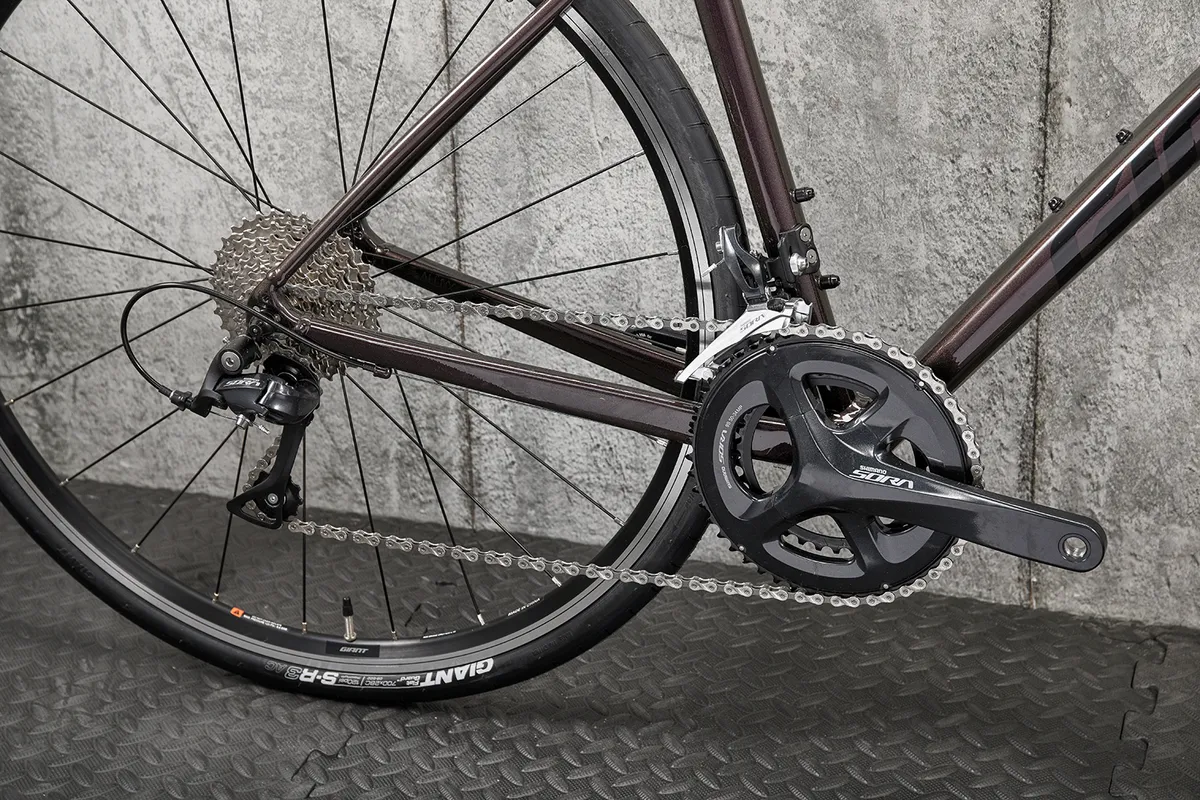
Giant says the Contend is “designed for aspiring riders aiming to ride a little faster and go a little further”. Those are aspirations that we probably all have at some time, and so I headed for my usual undulating training routes, but added a little extra on each time.
Fitted with 28mm tyres as standard, I set their pressures at 70psi, although could have gone a little lower on tarmac for my 78kg. As well as rural lanes, climbs, descents and all manner of road surfaces, I threw in some urban riding to add some unpredictability.
Giant’s compact frame design has always guaranteed a good fit in my experience, with generous overlap between neighbouring frame sizes, which usually accounts for riders with particular needs.
In this instance, circumstances dictated that I had to test a medium frame size, rather than my usual medium/large, but once I was on board, the difference of about 15mm reach was minimal, and didn’t affect my ability to get the most out of the bike.
The Contend has a well-designed and beautifully built frame, with tube shaping and profiles that mimic the carbon fibre Giant TCR in places.
Helping to enhance ride quality are the bike’s all-carbon fork and alloy D-Fuse seatpost.
Giant’s D-Fuse closely followed BMC’s original D-shaped seatpost design, and generates seated compliance from the flat rear face of the seatpost, which is engineered to flex fore and aft. The Contend’s seatpost diameter is slim too, which further helps incite flex.
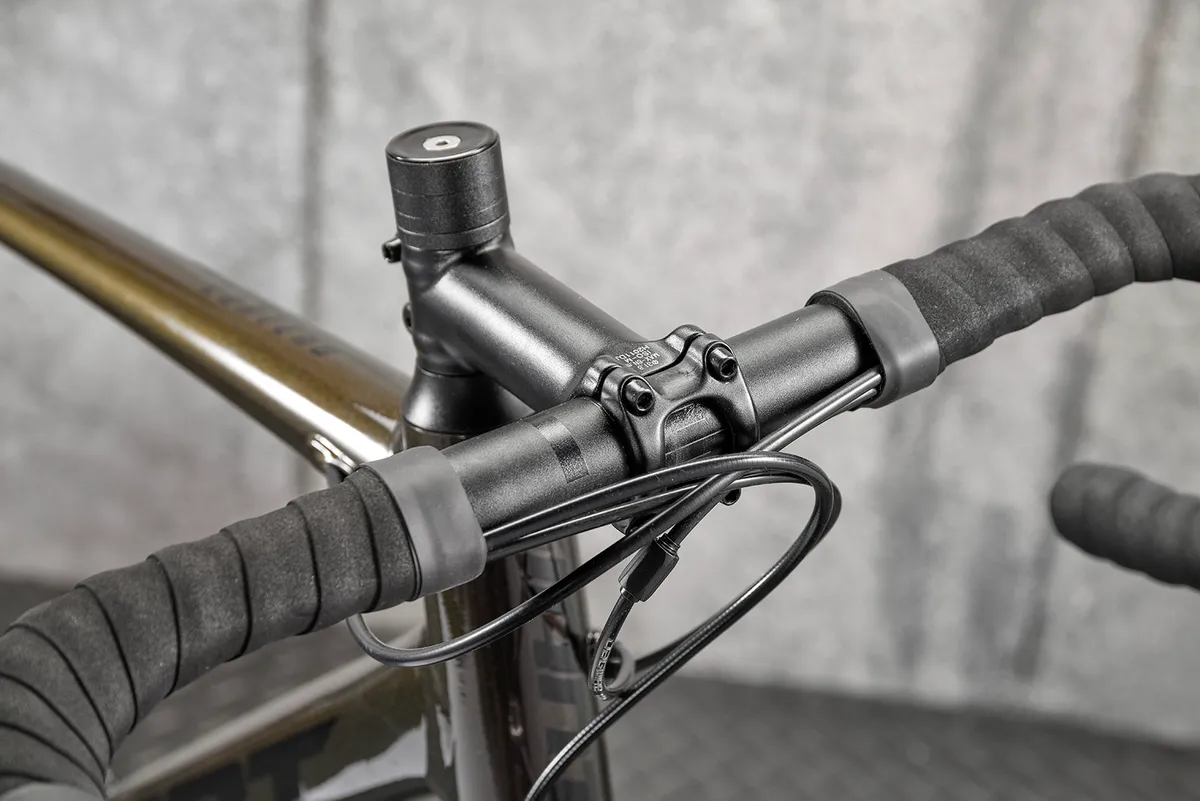
As with most manufacturers, Giant provides its own handlebar and stem. The bar is a comfortable compact drop shape, and the stem has nicely recessed bolts, which prevent knee strikes on sharp edges.
Although relatively few, there are some aftermarket OverDrive-sized stems available, should you ever want to upgrade.
The Contend’s derailleur cables are routed internally from a dual port in the head tube, and exit the down tube just in front of the bottom-bracket shell, while the rear brake runs through the top tube, entering on the right side, which gives the best route for a left-sided rear brake lever.
It looks very tidy, with no cables angling out from the upper down tube, and adds a touch of class to the polished aesthetics.
Shimano’s Sora groupset has a more upmarket look than Claris, with a pleasant, glossy anodised finish, matching threaded bottom bracket and bright silver nine-speed cassette.
The Tektro brake calipers aren’t finished identically, but tie in pretty well, and feel more like Shimano units. The fact that their performance didn’t stand out is a good thing, because they just did what I expected, without any fuss.

Supplied with 28mm tubeless-ready tyres, which measure 29mm wide on the Giant S-R3 rims, the Contend has room for 32mm rubber.
With appropriate tyre pressures, the Contend makes the most of its tyre volume, and with the D-Fuse seatpost helping to soak up vibration, the ride quality is very good.
Where some bikes rely on a squishy saddle, Giant’s Approach is firmer and very well-shaped. It feels supportive, and I’d expect it to retain its structure for longer than a very soft saddle. With less cushioning here, the smooth ride definitely owes much to the seatpost.
The front end, while not quite as well damped as the rear, still has great vibration absorption. It encourages you to take the faster line, even when the surface is questionable.
Grip from the Giant S-R3 tyres is consistently predictable, with their rounded shape and lower pressure giving great confidence in the corners. Refined ride quality and accomplished handling make outings on the Contend a relaxing, positive experience.
The Contend 1 isn’t a bike that appears content to just roll along and deliver a pleasant ride. It really responds to being pushed, which isn’t always the case at this price level.
The slightly taller alloy rims of the S-R3 wheelset add some rigidity, and even with larger tyres, they can accelerate quickly enough to make things fun, and aren’t anchors on long climbs.
Giant has long been a master of creating coherent bikes, where the result is often greater than the sum of its parts, and that’s the case with the Contend 1.
From its 1:1 34x34 lowest gear to high 50x11 top gear, it has the potential to take on almost any road, and that extra sprocket makes the cassette less gappy than the Claris 8-speed offering. The shifting is snappy and smooth, with comfortably ergonomic levers and brakes that are up to the task.
With space for larger tyres and mounts for full mudguards, the Contend 1 could be pressed into duty as a great commuting bike or winter bike, but it’s good enough to satisfy on every ride.
How does the Giant Contend 1 compare?

The Trek Domane AL 2 is £175 cheaper than the Contend 1, but has some similarities. Both have aluminium frames and a carbon fork, and both are designed to dampen road vibrations and bumps as much as possible.
How they do it differs, because the Trek has a very effective IsoSpeed fork, while the Giant has larger tyres and a specifically flexy seatpost. Their respective ride qualities are similar, although the Contend 1’s generally sporty feeling and willingness to progress wins for me.
The difference between the Trek’s Claris and Giant’s Sora groupsets is more than a single sprocket though, as the chainset, bottom bracket and brake shortcuts on the Trek detract from the rest of the mechanicals.
Shifting is less refined, there is noticeable lateral flex from the crank when standing on the pedals and the Domane’s brakes are very ordinary indeed.
On paper, and in weight terms, there’s little in it, but on the road, the additional cost of the Contend 1 is a sound investment in overall ride satisfaction.
Giant Contend 1 bottom line
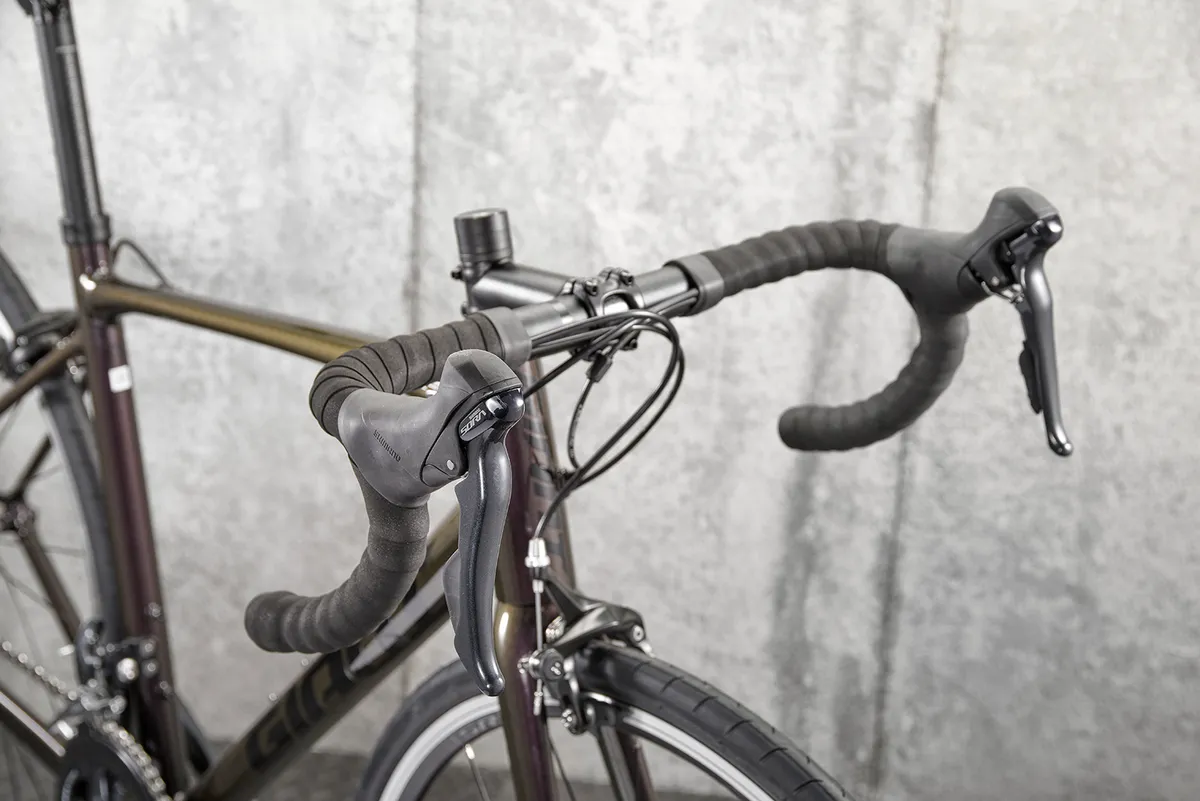
On this evidence, Giant’s Contend does more than that. It offers everything that a well-priced road bike should, with great looks, sound mechanicals, rewarding and reassuring handling, plus fine ride quality.
It’s practical too, and with rim brakes, relatively easy and inexpensive to repair and upgrade.
It comes with tubeless-ready rims and tyres, so could easily be converted to give some additional puncture security, and Giant dealers will usually do this for you.
Alternatively, just swing your leg over one, because the Contend is great fun to ride as it is.
Budget Bike of the Year 2022 | How we tested
Our 2022 Budget Bike of the Year testing was handled by regular BikeRadar contributors Simon Withers and Robin Wilmott – two highly experienced testers who have reviewed dozens of road and gravel bikes at the budget end of the market over the years.
Testing involved long rides on favourite routes around Bath, as well as laps of rolling hills in Somerset. Unlike our more performance-focused categories, the best road bikes around £1,000 are also more likely to be used for commuting by bike and other errands.
With this in mind, we’ve paid close attention to how easy the bikes are to live with for day-to-day use and how they fare on urban jaunts.
Our 2022 Budget Bike of the Year contenders are:
- Boardman ADV 8.9
- Forme Monyash 2
- Giant Contend 1
- Trek Domane AL 2
- Triban RC 500
Thanks to…
Thanks to our sponsors HUUB, Lazer, 100% and Garmin for their support in making Bike of the Year happen.
Product
| Brand | giant |
| Price | 999.00 GBP |
| Weight | 9.5100, KILOGRAM (M) - |
Features
| Fork | Advanced-Grade Composite, full-composite OverDrive steerer |
| br_stem | Giant Sport alloy |
| br_chain | KMC X9 |
| br_frame | ALUXX-Grade Aluminium |
| Tyres | Giant S-R3 AC 28mm |
| br_brakes | Tektro TK-B177 calipers |
| br_cranks | Shimano Sora, 50/34 |
| br_saddle | Giant Approach |
| br_wheels | Giant S-R3 |
| br_shifter | Shimano Sora 2x9 |
| br_cassette | Shimano, 11-34 |
| br_seatpost | Giant D-Fuse alloy |
| br_handlebar | Giant Connect alloy 42cm |
| br_bottomBracket | Shimano cartridge |
| br_availableSizes | S, M, ML, L, XL |
| br_rearDerailleur | Shimano Sora |
| br_frontDerailleur | Shimano Sora |
| Features | Extras: Threaded cartridge bottom bracket |

